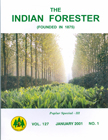An Economic Analysis of Poplar Cultivation
DOI:
https://doi.org/10.36808/if/2001/v127i1/2759Abstract
Poplars have an important role in both increasing the productivity of land and in afforestation programme. Moreover, the wood is used for forming well crabs, lacquer work, turnery, plywood, etc. Poplar plantation also increased opportunities of employment in rural sector. With this view, the study was conducted to analyse cost of returns from Poplar plantations in Yamunanagar District. The analysis indicated that cost of plant material accounted to maximum'i.e. 34 per cent of total establishment cost. The operational cost was Rs. 2,800 per annum per acre during first six years. The total annual cost also did not vary much with age of trees. The discounted cash flow of Poplar plantation results in constant annual net returns per acre over the entire rotation were Rs. 22,156 and Rs. 29,332 without intercropping and within intercropping, respectively. The cost-benefit ratio also favoured plantation of Poplars in the region.Downloads
Download data is not yet available.
Downloads
Published
2001-01-01
How to Cite
Dhillon, A., Sangwan, V., Malik, D. P., & Luhach, M. S. (2001). An Economic Analysis of Poplar Cultivation. Indian Forester, 127(1), 86–90. https://doi.org/10.36808/if/2001/v127i1/2759
Issue
Section
Articles
License
Unless otherwise stated, copyright or similar rights in all materials presented on the site, including graphical images, are owned by Indian Forester.





